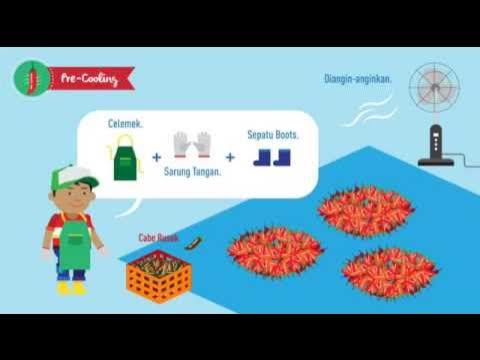Penanganan Pascapanen Padi
Summary
TLDRThis video script outlines the critical stages of post-harvest handling in rice agribusiness, starting from determining the right harvest time, using appropriate harvesting tools and techniques, to separating rice from chaff. Key processes include transportation, drying using innovative Yufi dryers, cleaning, sorting, packaging, and milling the rice into consumable forms. The script emphasizes the importance of meeting national standards for quality control and the use of ergonomic and efficient systems. Overall, the video aims to educate viewers on how each stage in post-harvest rice processing contributes to maintaining quality and maximizing value.
Takeaways
- 😀 Post-harvest handling of rice is a subsystem of the rice agribusiness system, covering activities from harvest to producing rice or rice flour.
- 😀 Determining the right time for harvest is crucial and can be done through visual observation or using a moisture tester to assess rice's water content.
- 😀 Harvesting should be done at the right age with appropriate tools and machinery that meet technical, health, economic, and ergonomic standards.
- 😀 Threshing separates rice grains from the stalks and straw, which is an essential step after harvesting.
- 😀 Transporting the harvested rice to another location must be done carefully to preserve the quality of the grains.
- 😀 Drying is vital for reducing the moisture content of the rice to an acceptable level, ensuring it is ready for milling.
- 😀 The use of a Yufi dryer allows for efficient drying, even in rainy weather, with a drying time of 2-3 days during dry weather.
- 😀 Cleaning and sorting rice during or after threshing helps improve storage life and increases its market value per weight unit.
- 😀 After cleaning and sorting, the rice is packaged and stored until it is ready to be milled into rice.
- 😀 Milling transforms rice grains into edible rice, which is the final step in the post-harvest process.
- 😀 Quality standardization of rice and milled rice products is done according to Indonesian National Standards (SNI).
Q & A
What is the importance of determining the correct harvest time for rice?
-Determining the correct harvest time is crucial as it ensures the rice reaches optimal quality. Harvesting too early or too late can negatively affect the yield and quality of the rice. This is done through visual observations and moisture content testing.
What tools can be used to determine the right time to harvest rice?
-The right time for harvesting rice can be determined through visual inspection of the rice plants and by measuring the moisture content using a moisture tester.
Why is threshing an important step in post-harvest handling?
-Threshing separates the rice grains from the straw and husks, which is essential for preparing the rice for milling and further processing.
How can the quality of rice be maintained during transportation after threshing?
-During transportation, care must be taken to avoid damage to the rice. The rice should be handled gently, stored in proper containers, and kept in suitable conditions to prevent contamination or quality degradation.
What is the purpose of the drying process in post-harvest rice handling?
-The drying process reduces the moisture content of the rice to a safe level for storage and milling, preventing spoilage and ensuring the rice can be stored for long periods without quality loss.
What is a 'Yufi Dryer', and how does it benefit the drying process?
-A 'Yufi Dryer' is a modern drying system that uses a movie dryer to efficiently dry rice, even in wet weather conditions. This technology ensures that rice drying can continue during rainy weather and reduces drying time on clear days.
How does cleaning and sorting improve the quality of rice?
-Cleaning and sorting remove impurities and damaged grains, improving the storage life and marketability of the rice. It also ensures that only high-quality rice is packaged for sale.
What is the final stage of post-harvest rice processing?
-The final stage is milling, where rice is processed into its final forms—either as edible rice or rice flour. This step prepares the rice for consumption or sale.
What role does standardization play in the post-harvest process?
-Standardization ensures that the rice meets national quality standards (SNI) and is consistent in quality. This guarantees that the rice is fit for sale in the market and meets consumer expectations.
Why is proper post-harvest handling important for rice agribusiness?
-Proper post-harvest handling is essential to ensure the quality, safety, and marketability of rice. It improves storage life, reduces waste, and enhances the overall value of the product in the market.
Outlines

Cette section est réservée aux utilisateurs payants. Améliorez votre compte pour accéder à cette section.
Améliorer maintenantMindmap

Cette section est réservée aux utilisateurs payants. Améliorez votre compte pour accéder à cette section.
Améliorer maintenantKeywords

Cette section est réservée aux utilisateurs payants. Améliorez votre compte pour accéder à cette section.
Améliorer maintenantHighlights

Cette section est réservée aux utilisateurs payants. Améliorez votre compte pour accéder à cette section.
Améliorer maintenantTranscripts

Cette section est réservée aux utilisateurs payants. Améliorez votre compte pour accéder à cette section.
Améliorer maintenant5.0 / 5 (0 votes)






